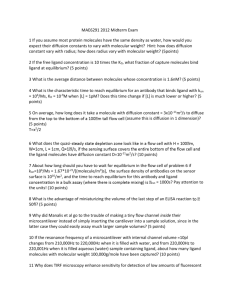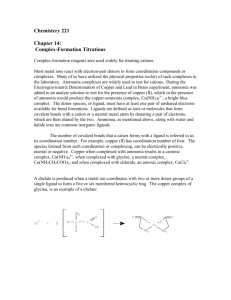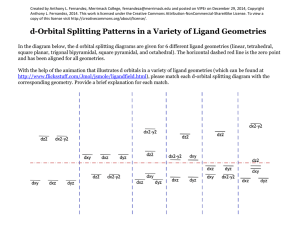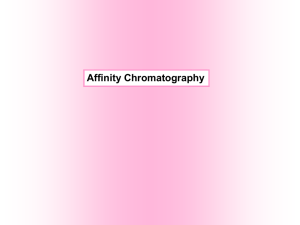Post-lab " Chemistry of copper
advertisement
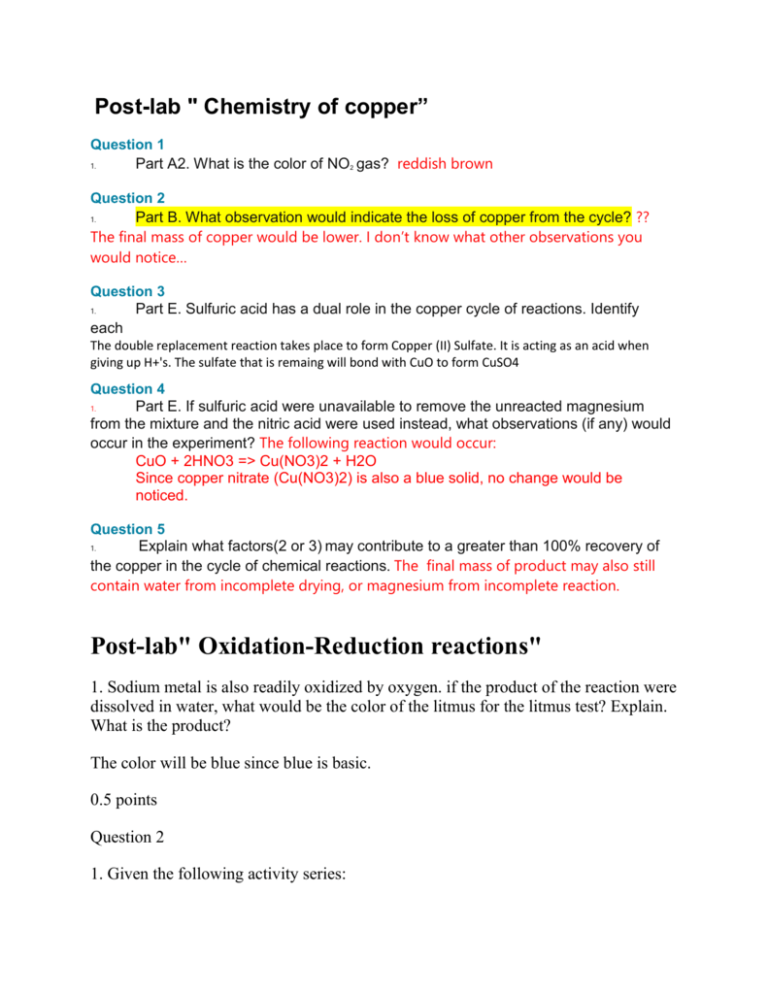
Post-lab " Chemistry of copper” Question 1 1. Part A2. What is the color of NO2 gas? reddish brown Question 2 1. Part B. What observation would indicate the loss of copper from the cycle? ?? The final mass of copper would be lower. I don’t know what other observations you would notice… Question 3 1. Part E. Sulfuric acid has a dual role in the copper cycle of reactions. Identify each The double replacement reaction takes place to form Copper (II) Sulfate. It is acting as an acid when giving up H+'s. The sulfate that is remaing will bond with CuO to form CuSO4 Question 4 1. Part E. If sulfuric acid were unavailable to remove the unreacted magnesium from the mixture and the nitric acid were used instead, what observations (if any) would occur in the experiment? The following reaction would occur: CuO + 2HNO3 => Cu(NO3)2 + H2O Since copper nitrate (Cu(NO3)2) is also a blue solid, no change would be noticed. Question 5 1. Explain what factors(2 or 3) may contribute to a greater than 100% recovery of the copper in the cycle of chemical reactions. The final mass of product may also still contain water from incomplete drying, or magnesium from incomplete reaction. Post-lab" Oxidation-Reduction reactions" 1. Sodium metal is also readily oxidized by oxygen. if the product of the reaction were dissolved in water, what would be the color of the litmus for the litmus test? Explain. What is the product? The color will be blue since blue is basic. 0.5 points Question 2 1. Given the following activity series: most active Ba, Mn, Cr, Cd, Sn, H, Bi, Au, least active 1. 3Mn(s) + 2Cr3+(aq) → 3Mn 2+(aq) + 2Cr(s) yes 2. 2Bi(s) + 6H+(aq) → 3H2(g) + 2Bi3+(aq) no 3. 3Cd2+(aq) + 2Au (s) → 3Cd(s) + 2Au(aq) no 4. Sn(s) + 2H+(aq) → H2(g) + Sn2+(aq) yes 5. 2Cr3+(aq) + 3Ba(s) →3 Ba2+(aq) + 2Cr(s) yes 6. 2Au3+(aq) + 3H2(g) → 6H+(aq) + 2Au(s) yes 7. 3Mn 2+(aq) + 2Bi(s)→ 3Mn(s) + 2Bi2+(aq) no Predict which of the following reactions occur (use yes or no for the answer): I checked these and your answers are correct Post-lab" Transition Metal Complexes" Question 1 1. a) What is a ligand? A ligand is a molecule (or an ion) that binds to a metal ion to form a coordination complex. The coordination number determines the number of that ligand that will bind to the central metal ion. b) Distinguish between a monodentate ligand and bidentate ligand. Denticity refers to the number of binding sites per ligand. A monodentate ligand binds to the metal ion only one time, while a bidentate ligand binds to the metal ion two times. A polydentate ligand is called a chelate complex, and stability of complexes increases as the denticity increases. Question 2 1. Which complex is predicted to be more stable, [Co(en)6]2+ or [Co(NH3)6]2+ ? Explain. ?? Equally stable because they are both bonding the same number of times. Question 3 1. The five ligands- Cl-, NH3, H2NCH2CH2NH2, SCN-, and H2O- studied in this experiment. Which ligand appeared to be the strongest ligand? Why? This will depend on your results. In general, the one with the biggest color change is the strongest ligand. I’d guess the results would be: weakest H2O < SCN- < Cl- < NH3 < H2NCH2CH2NH2 strongest Question 4 1. Ligands A and B form the complexes [MA6]2+ and [MB6]2+, where M is a divalent ion. When NaOH is added to sepatate solutions containing the complexes, a precipitate forms in the solution containing [MB6]2+ complex but not in the solution containing the [MA6]2+ complex. a. Write the formula for the precipitate. M(OH)2 (solid) b. Which ligand is the stronger ligand? B, because the solution did not precipitate. In the other complex, the metal bonded with OH- instead of the weak ligand A. c. Which complex is more stable? [MB6]2+ is more stable because the ligand is stronger. Question 5 1. Write the formula of the complex formed between a. water, the ligand, and copper(II) ion, assuming a coordination number of four. [Cu(H2O)4]2+ b. ethylenediamine( abbreviated en), the ligand and nickel(II) ion, assuming a coordination number of six. [Ni(en)3]2+ Post-lab"Thermodynamics of the Dissolution of Borax"Question 1 1. Describe the preparation of 200ml of 0.50M HCl, starting with "conc" HCl (12M). Calculate moles of HCl needed: .2 l * .5 M = .1 mol Now I would need half as many moles of carbonate as HCl: .1 *1/2 = .5 mol Na2CO3 From the 12 M sample, I need to determine volume needed to reach 1 mol. now from the 12 M sample determine volume needed to reach .1 mol: .1/12 = 8.33 ml Now volume of water added will equal 200 ml - 8.33 ml 191.67 ml volume of 12M HCl is added. 1 points Question 2 1. From a data plot, the ∆H for the dissolution of a salt is +1.4x102kJ/mol and the ∆S is +304 J/mol K. What is the free energy change for the dissolution of the salt at 240C? Using equation 26.5 free energy change = 1.4 *102 -297*.304 = 49.7 free energy change. 1 points Question 3 1. The sodium carbonate, used for the standardization of the hydrochloric acid, was not anhydrous, but rather contained some water of hydration. How does the mistaken use of nonanhydrous sodium carbonate affects the measured standardized molar concentration of the hydrochloric acid solution? Explain. Because water adds its own mass, you would think that more moles of sodium carbonate was added than what actually was. The measuerment would be off in proportion to the mass of water added. Since Carbonate neutralizes H+ ions at a 1:2 ratio, you would be off by double the number of falsely calculated moles of carbonate. Question 4 1. The molar solubility of salt with the general formula, M2Q, is 2.3x10-3 mol/L. 1. What is the Ksp of the salt? Getting KSP from molar solubility Ksp = (2*2.3*10-3)2 * (2.3*10-3) = 4.9 * 10-8 2. What is the free energy change for the dissolution of the salt at 250C? (R=8.314x10-3kJ/mol K) Using equation 26.1 free energy change equals = -8.314*298*ln(4.87)= 41.7 kj/mol
